kilometres south-west of Sydney, just over one hours drive from Canberra, in the Southern Tablelands
The town of Braidwood is classified by the National Trust and listed on the NSW State Heritage Register.
Before the arrival of the British, the land around Braidwood was occupied by Aboriginal people who were speakers of the Dhurga language group, of the Yuin nation.
Aboriginal people called the area around Braidwood, “Wigwigly” meaning ”plenty of fur”, which relates to the plentiful
sources, from such animals as possums, koala and kangaroo.
Most Aboriginal people belong to a totemic group. A totem is usually a natural object, plant or animal, that is inherited by member's of a clan or family, as their spiritual emblem (
). At birth, many Aboriginal people may receive a skin totem and a clan totem.
The best known spiritual animals connected with the Yuin people are the Pacific Black Duck (Umbarra) and the Black Swan. The Yuin word for a personal spiritual connection with an animal,
, literally means "my friend" (from moodji, friend, and gaarl, my).
It is highly likely that the Yuin people used what Hotchin (1990) described as a general east-coast toolkit, which
and rugs of possum skin, various types of fighting clubs and hunting and fighting spears (Keen 2004: 96).
Polygamy appears to have been practiced by older and more powerful men of the Yuin people. (Howitt 1904: 266). However, marriage was often based upon relationships, with elders selecting a "mother-in-law, rather than of wife". The mother-in-law would then give birth to the wife of a selected male child (Elkin 1976: 210).
The spirt creator beings, Tunku and Ngardi, in Yuin Dreamtime stories, came down from a star to inhabit the earth. They then became
part of the rocks and earth and the trees and mountains.
The combined effects of smallpox, tribal battles and venereal disease devastated the Aboriginal populations around Braidwood, especially from 1800 to 1850.
 |
| Aboriginal Australian man, British Library’s catalogue |
 |
| Aboriginal domestic scene. The etching was executed by German artist Gustav Mützel, who worked from the sketches of German explorer Johan Wilhelm Theodor Ludwig von Blandowski. Showing Marn Grook, he traditional Indigenous Australian football game played at gatherings and celebrations of sometimes more than 100 players |
The British
In 1822, Hamilton Hume along with Alexander Berry, explored the upper reaches of the Clyde River, almost as far as Braidwood. William Kearns, William Packer and Henry Marsh, accompanied by an Aboriginal guide, reached Braidwood in 1822. Previously these men had been involved in Charles Throsby's
explorations of the Southern Highlands.
After this, the Braidwood area attracted settlers with the first land grant made in 1825, to Sydney surgeon, Dr Thomas Braidwood Wilson, who called his property Braidwood farm ( later changed to Mona).
The town of Braidwood was named after Dr Thomas Braidwood Wilson, a settler and a surgeon in the Royal Navy, who
served as surgeon-superintendent on several convict ships. By many accounts, Dr Wilson was an admirable man, who took great care with the lives' of the convicts entrusted to him, by insisting on cleanliness and daily rations of lime juice and wine. He wrote in his journal ".....I seldom have recourse to flogging, being enabled
to preserve order without it, and finding other measures more effective".
Dr Wilson also, tried to
assist and understand the Aboriginal people in the locality of Braidwood. Generally, he showed great compassion and concern
for the people around him and
the Aboriginals who were dying of European diseases. Dr Wilson was frequently called, "Bonny Dr Tom".
 |
| Thomas Braidwood Wilson. Date before 1843 |
Getting There
Getting to Braidwood from Sydney
required travelling via Berrima and Goulburn. A rough journey which took about 6 weeks on a bullock wagon, probably camping on the side of the road.
In 1827, Surveyor Robert Hoddle rejected the feasibility of a road between Braidwood and the Clyde River.
The official 1828 census showed an official population in the area of about 90, of whom fifty percent were convicts, eleven percent were ex-convicts and seven percent had a ticket of leave.
First Land Grants
1829: Captain Duncan and Margaret MacKellar were granted “Strathallan”, 2000 acres in 1822, but didn't move onto the land until 1829. Captain Mackellar was appointed to the bench in 1833, assisted by a policeman and a scourger (flogger).
1826: Captain John Coghill was the Master
of the convict transport ship "Mangles". He built "Bedervale" homestead in 1836, on a land grant he selected in 1826 at Braidwood.
1827: Duncan Mackellar at “Jinglemoney”.
1827: George Bunn at “St Omer”, This property was owned by Captain Bunn but he never occupied it.
1828 - William and James Ryrie at “Arnprior” and “Jingamona” (1828).
1828: Major Elrington at “Mt Elrington”, first magistrate in the district, who kept a loaded pistol ready, even while eating in his dining room.
 |
| House of Major Elrington, for many years Chief Magistrate of the Braidwood and Araluen districts, Sunday Times (Sydney, NSW : 1895 - 1930), Sunday 16 December 1923 |
1835: “Exeter Farm” Jembaicumbene. Land granted and purchased by William Henry Roberts.
Dr Thomas Braidwood Wilson settled at Braidwood in about 1836 and became engaged in sheep and cattle farming. In 1837, he used his own money to build a courthouse, where he took on the duties of a part-time magistrate. Dr Wilson also worked as a doctor in the district, but he encountered personal tragedies, when his infant son died followed by his wife, who passed away in the following year of 1838. Dr Wilson became bankrupt, as a
result of the drought and economic depression in the late 1830s.
Bushrangers and convicts were active around Braidwood, and so, a courthouse and lock-up ( 1837-38) were built and the town was established around these buildings.
 |
| Braidwood Courthouse, NSW, built about 1837, Australian Town and Country Journal (Sydney, NSW : 1870 - 1907), Saturday 6 December 1890 |
Town Plans
In 1839, James Larner surveyed the town to include a recreation area around the courthouse and on instructions from Governor Darling, planned the town with wide streets. Larner then settled in Braidwood and built the Royal Hotel and later a building for the Grand United Order of Oddfellows, another benevolent society, and now Braidwood and District Historical Museum.
 |
| Drawing of the Braidwood Museum. Thebuilding was built in the 1840s as the original Royal Hotel. It was sold to the Grand United Order of Oddfellows for an Oddfellows Hall for £700 in 1870 |
The residents of Braidwood petitioned the Colonial Secretary in 1839 for a road from Braidwood to Batemans Bay. However, in 1839, prominent landholders from around Braidwood, such as Dr. Thomas Braidwood Wilson and Nerriga decided to build their own road from Nerriga to Jervis Bay.
The first sale of land allotments at Braidwood occurred in 1840. By the following year, 1841, Braidwood and the surrounding area had a population of 1100, with about half of the residents being convicts.
The Wool Road was constructed privately in 1841, linking the inland area around Braidwood to the South Coast. It was built using convict labour, to provide a shorter route to a seaport for wool grown at Braidwood and the surrounding areas. Some parts of the Wool Road are only accessible to four-wheel-drive vehicles today.
The first school at Braidwood opened in 1849.
Gold!
Alluvial gold was found in the Araluen Valley, near Braidwood in 1851, which started a gold rush. People
flooded into the country and headed to Braidwood from Britain, Europe, North America and China, with great hopes of striking it rich.
 |
| View of the Araluen Valley, from the mountain, Australian Town and Country Journal (Sydney, NSW : 1870 - 1907), Saturday 24 February 1894 |
Braidwood began to change in character from a sedate Georgian town, into a brash and boisterous gold-mining town.
The population grew from 1100 in the 1841 census to 1429 people residing in the local Braidwood Police District in 1851, 212 people lived in the town.
 |
| Goulburn Herald and County of Argyle Advertiser (NSW : 1848 - 1859), Saturday 11 July 1857 |
 |
| Braidwood Hotel, NSW, was Known as the Commercial Hotel until 2004, was built in 1859 |
The foundation stone of St Bede's Catholic Church laid in 1858. The Wesleyan Church in Duncan Street was built 1856 and the Presbyterian Church constructed in 1861.
Infamous Bushrangers
The bushrangers, John and Thomas Clarke, had a price on their heads for a reported 71 robberies and hold-ups and the death of at least one policeman. They were captured after a shootout lasting six hours. Two months after their capture, Tom and John Clarke were hanged.
Australia's first Royal Commission took place in Braidwood in 1867, into the state of crime in the Braidwood district. This Royal Commission was motivated by the violent crimes of the notorious Clarke brothers.
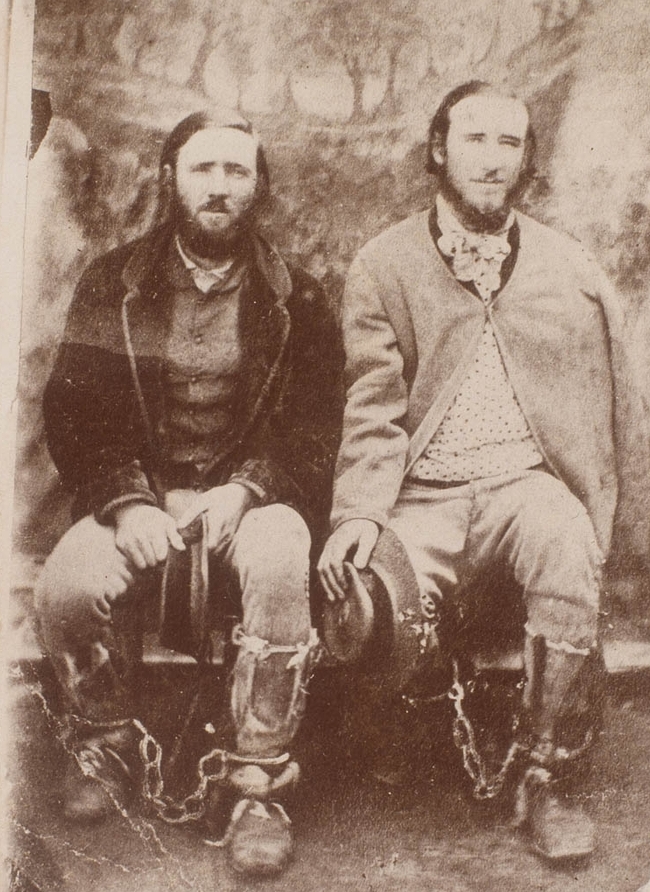 |
| Australian bushrangers Thomas and John Clarke under arrest in Braidwood Jail. |
Literary Institute
The Braidwood Literary Institute was built “to elevate the tone of Moral and Intellectual attainment in the minds of all members of the community”, in 1869. Women were allowed to join only, as associated members and they could not use the Reading Room.
 |
| The Literary Institute, Braidwood, New South Wales, built in 1869, circa. 1910 |
The Anglican Church and rectory was built in Wilson Street in 1856.
The Chinese
The Chinese were the largest non-British population at Braidwood following the gold rush. Almost all of the Chinese were men, as women and wives were not brought out to Australia as most of the Chinese intended to return home after they had made their fortune.
Quong Tart
Quong Tart was born in 1850 in a village in Guangdong province, China. He
arrivied on the goldfields near Braidwood at age nine, with his uncle. While living in Braidwood, Quong worked in a store owned by Thomas Forsyth and his wife, where he picked up a Scottish accent and love of the poet Robert Burns.
The wealthy Simpson unofficially adopted Quong and at the age of 18, Quong was wealthy, as the Simpsons had
encouraged him to invest in gold claims. Quong was a popular and colourful character, a member of the local cricket team and a Freemason.
Quong was to become a successful tea merchant, captain of the local cricket team, started a football team and promoted horse-racing. He was also a generous philanthropist
He met his future, Anglo-Celtic wife, Margaret Scarlett, when she was teaching in a small private school in Braidwood. Her parents did not approve of the match, but she married Quong anyway, after her 21st birthday. Margaret described him as "Scotch in instinct and sympathy".
When Quong Tart died, 200 men escorted his coffin from his Ashfield mansion, Gallop House, to a train heading to Rookwood Cemetery.
 |
| Quong Tart and his wife Margaret, Sunday Times (Sydney, NSW : 1895 - 1930), Sunday 17 October 1920 |
Nam You
Nam You was a Braidwood storekeeper who ran a mining business in the late 1880s, in partnership with Quong Tart and the Nomchong family.
 |
| Portrait of Nell Nomchong, an early Braidwood settler, wearing her mother's wedding frock, 1877 |
Chee Dock
Some Chinese people ran businesses like Chee Dock, who had been living in California before he came to Australia. Chee Dock and his Chinese wife were Roman Catholics and as well as engaging in various business ventures they had 13 children together. Wallace Street, Braidwood had many Chinese shops.
 |
| Chee Dock is second from the right and his second wife Mary is sixth from the left in the photograph, early 1900s. National Library of Australia |
 |
| Wallace St, Braidwood, NSW, Australian Town and Country Journal (Sydney, NSW : 1870 - 1907), Saturday 24 February 1894 |
Ah How
Chinese store owner and publican, Ah How, ran the
All Nations Hotel, at Jembaicumbene, located 8 km (5 miles) out along the Braidwood–Majors Creek Road. The
Braidwood Monitor reported that he was probably "the first Chinaman who has applied in this colony to become a licensed victualler". The Clarke gang were also involved in a hold up at Ah How's store in 1866.
The Town Grows
The gaol at the northern end of Wallace Street was built to contain twelve prisoners. In 1862 the Gaoler was Mr Robert K Waters, along with Mrs Mary Ann Waters as Matron.
The town's population was at 1197 in 1871.
 |
| Braidwood, N.S.W. between 1875 and 1938, SLVIC |
 |
| Post Office, Braidwood, NSW and the hospital, Australian Town and Country Journal (Sydney, NSW : 1870 - 1907), Saturday 6 December 1890 |
 |
| Flour mill, Braidwood, New South Wales, ca. 1890, National Library of Australia |
The Irish also came out for the gold. Many settled a short drive from Braidwood at Reidsdale, also called "Irish Corner". This fertile area has a micro-climate which favoured farming. In 1912, various traditional Irish
family farms merged to form the Reidsdale Cheese Making Cooperative.
Photos Late 1800s- 1900s
Braidwood population peaked in 1901.
 |
| Horse drawn transport of produce at the flour mill, Braidwood, New South Wales, circa 1880 |
 |
| Braidwood, N.S.W. Abt. 1890 (State Library of Victoria) |
 |
| Braidwood from the Araluen-road, NSW, Australian Town and Country Journal (Sydney, NSW : 1870 - 1907), Saturday 24 February 1894 |
 |
| Site of the former Doncaster Hotel, which was built around 1840 and then added to and converted to a covent. St. Bede's Good Samaritan Convent was opened by Bishop Higgins in 1890, Freeman's Journal (Sydney, NSW : 1850 - 1932), Thursday 25 November 1909 |
 |
| A large Anglican Church was built in Elrington St and was dedicated in 1892. Sunday Times (Sydney, NSW : 1895 - 1930), Sunday 16 December 1923 |
 |
| Motor cyclists of Braidwood, NSW - 1903, Braidwood Historical Society |
 |
| Braidwood Dispatch and Mining Journal (NSW : 1888 - 1954), Friday 27 May 1927 |
 |
| Braidwood, N.S.W. - very early 1900s Kaye |
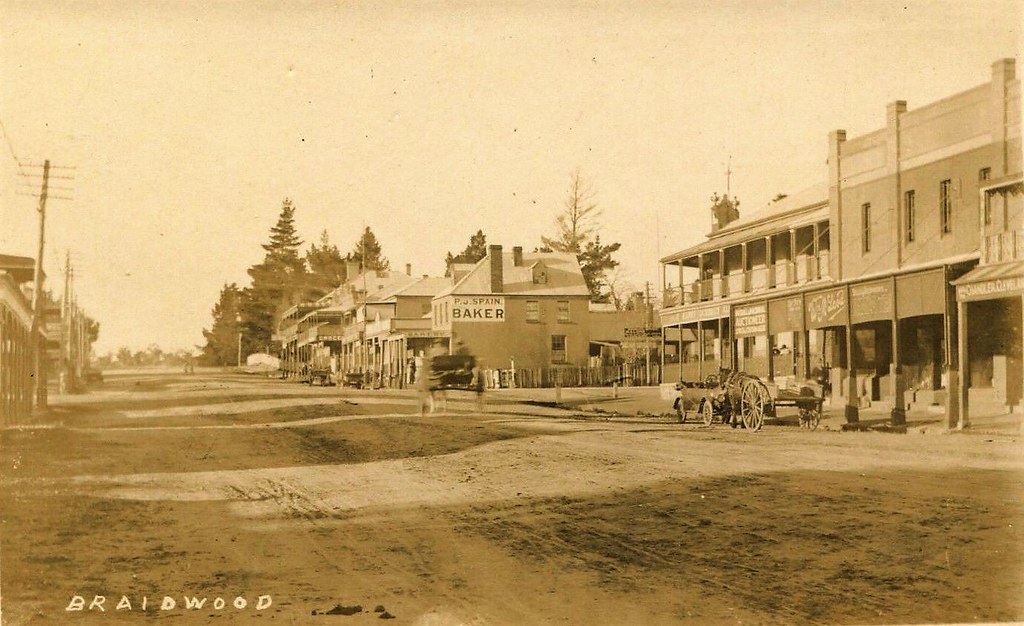 |
Braidwood, N.S.W. - early 1900s
|
.jpg) |
| Braidwood Brass Band, on Garnet Madrell's truck. Braidwood, NSW. National Library of Australia |
 |
| View of Braidwood, N.S.W. - early 1900s, Aussie Mobs |
 |
| Major's Creek, near Braidwood, N.S.W. - very early 1900s, Aussie Mobs |
 |
| Braidwood Show, Sydney Mail and New South Wales Advertiser (NSW : 1871 - 1912), Wednesday 10 March 1909 |
 |
| Car in front of the Nomchong Brothers garage, Braidwood, New South Wales, circa 1930. Nomchong and his son established Nomchong Bros carrying service and bought a 6-wheeler lorry. The family, of Chinese descent, was well integrated into the local Braidwood community and operated the local garage and service station. In 1900, the family ran a small grocery shop in the Albion building. |
 |
| Braidwood Dispatch and Mining Journal (NSW : 1888 - 1954), Friday 31 July 1936 |
 |
| Truth (Sydney, NSW : 1894 - 1954), Sunday 2 January 1938 |
 |
| Braidwood, NSW, aprox. 1930s |
 |
| Wehby's Shop and Truck, Braidwood, July 1949, State Records NSW |
Film Location
Various films have used Braidwood as a location, including,
Robbery Under Arms (1920),
Ned Kelly (1970),
The Year My Voice Broke (1987),
On our Selection (1995),
Finding Joy (2003),
The Discontinuity (2009) and
Australia's Most Haunted (2013). And, famous
Australian poet Judith Wright moved to a property near Braidwood in 1976.
Judith Wright
When Judith Wright moved to Braidwood in 1975, it was so she could be closer to HC "Nugget" Coombs her lover of 25 years, who was based in Canberra. The pair, whose relationship was known about by very few people, shared a love of literature, the environment and Aboriginal rights.
Today, Braidwood is a thriving and vibrant town which welcomes many tourists each year.
Around Braidwood
 |
| The Braidwood Literary Institute, NSW, circa 1869 |
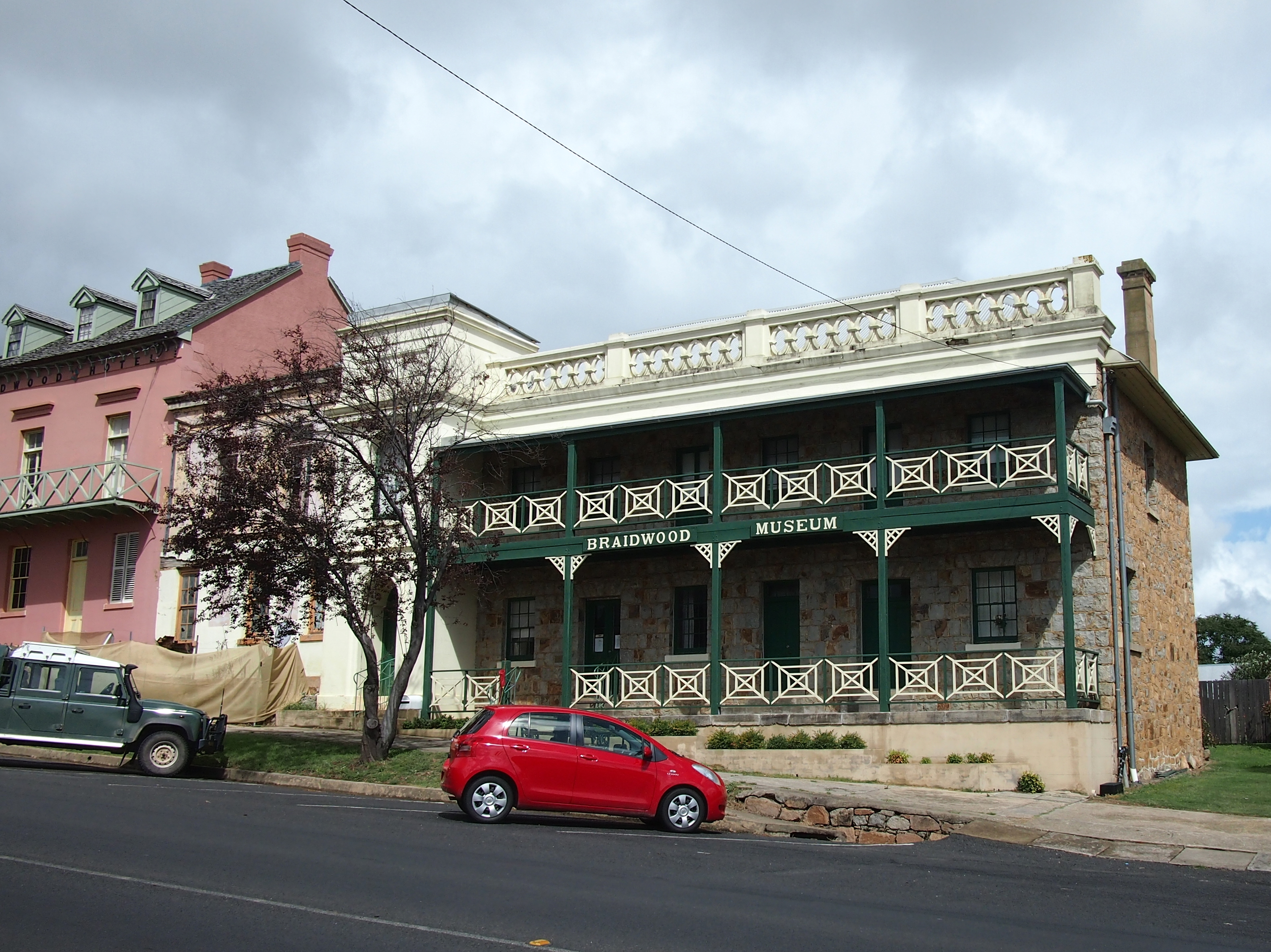 |
| Braidwood Museum. Built in the 1840s as the Royal Hotel, built by James Larmer, building. Later used for the Grand United Order of Oddfellows, a benevolent society |
 |
| The Braidwood Hotel. Circa 1859 |
 |
| Bedervale, Braidwood, NSW, built 1842 |
 |
| Another view of Bedervale, Braidwood, NSW, built 1842 |
"Bedervale", a Georgian style homestead in Braidwood, was designed by John Verge in 1836 and finished about 1842, for John Coghill. Coghill was part owner and Captain of the convict ship the "Mangles", which made four trips from England to New South Wales between 1820-6. Coghill employed Patrick Hickey on his property at one stage, who born about 1789 in Tipperary, Ireland and who was transported to Sydney in 1829. Hickey was indentured to Captain John Coghill at Bedervale. The Bedervale property has been in the ownership of the same family for more than 120 years and the interior of the homestead has barely changed since the Edwardian period.
 |
| The Royal Mail Hotel Braidwood, circa 1890 |
The Royal Hotel was built in 1890 by James O'Brien. Back during the gold rush, the hotel was a staging point for coaches. The hotel was also used when Mick Jagger starred in the 1970 Ned Kelly film.
 |
| The former Albion Hotel, Braidwood, NSW. Hotel built from c. 1872 |
 |
| Braidwood NSW Post Office built in 1865 as the telegraph station, with Post Master's residence next-door |
 |
| Mona Homestead, built in 1853, Braidwood, NSW |
 |
| Shops in Braidwood, NSW |
.jpg) |
| The Commercial Bank, Braidwood, NSW. Circa 1888 |
.jpg) |
| Irreplaceable architecture in Braidwood, NSW |
 |
| Braidwood Court House built 1884, Braidwood, NSW |
 |
| Bendoura, built 1859, Braidwood, NSW |
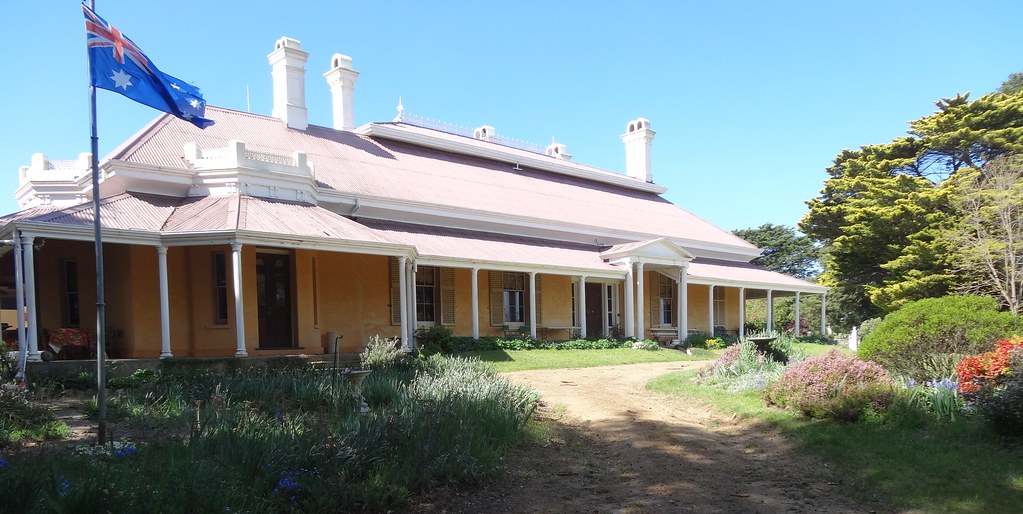 |
| Bedervale House NSW near Braidwood. Built in 1842 (flickr) |
 |
| Old buildings in Braidwood, NSW |
 |
| 123 Wallace St, old world charm, Braidwood, NSW |
 |
| Historic cottage in Monkittee St Braidwood, NSW |
 |
| Tidmarch built as an inn by Braidwood’s first Clerk of Court, Patrick Goulding, in 1856 |
 |
| Braidwood Road (1856 route). Preserved section of 1856 road near where it merged with the older (1841) Wool Road that emerged from the Bulee Gap cutting (shown in the centre background). (February 2019) TrimmerinWiki |
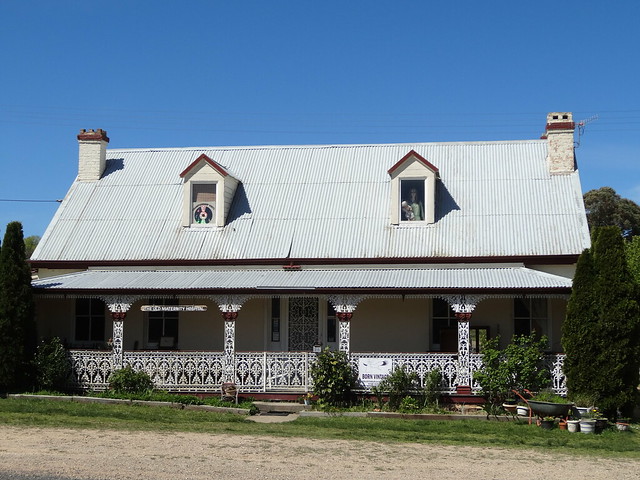 |
| The old Maternity Hospital in Braidwood NSW was built in 1854 by Anne Gardiner who was the sister of the infamous Clarke Brothers bushrangers denisbin |
 |
| Originally part of the 1830s Roberts and Badgery estate, Mill Pond Farm was the earliest dairy in Braidwood. Later provided stabling for the family’s racehorses and the Steam Flour Mill of C E Dransfield and his wife in 1859. |
 |
| St Andrew's Braidwood, Braidwood, New South Wales, was completed in 1892 |
 |
| The Granite Store in Braidwood NSW, built by stonemason Terence McGrath. It was built in 1870 |
 |
| The Lodge of Truth in Braidwood, NSW. Once had a second storey. This facade has changed over the years, this one altered 1907 |
 |
| 91 Wallace Street, Braidwood, NSW |
 |
| Former Australian Stock Bank, Wallace Street, Braidwood, NSW |
 |
| The Albert Buildings, later became a steam driven flourmill and shops by Hendricks and Jacobs |
 |
| Braidwood, NSW |
 |
| Former Bank of New South Wales building, braidwood, NSW |
 |
| The Pound Keepers cottage, circa 1839, Braidwood, NSW |
Things To Do and Places To Go
Novels Set in Braidwood
Worth Fighting For (2016), a novel by Mary-Anne O’Connor, focusses on the WWII experience, when war breaks out war in Papua New Guinea, and the threat to Australia’s shores. The character, Junie Wallace, lives with her family on a farm in Braidwood, New South Wales.

























.jpg)

















.jpg)
.jpg)




















